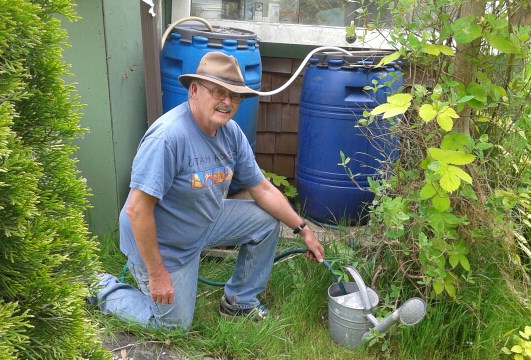Last year, El Nino brought the Lower Mainland steady days of sunshine, high humidity and hot weather. It was a wake up call on realizing water is not a renewable resource at certain times of the year.
Watering restrictions are again in effect, two weeks early this year.
Drought conditions can be a gardener’s worst nightmare. When a hot, dry weather pattern settles in, it affects your landscape in a variety of ways. There’s nothing you can do to prevent a drought, but there are some strategies you can do to help minimize the effect it has on your landscape.
The most obvious way a drought affects your garden is the way it makes your plants look: Healthy green leaves wilt, develop crispy brown edges, or die completely; flowers fade more quickly or fail to appear at all; and plants (even weeds) grow more slowly. Drought weakens your plants, increasing how susceptible they are to attack from insects and disease.
It also makes plants less winter-hardy, especially if the drought occurs in the fall as plants are going dormant. The hot, dry conditions have a lasting effect, too. Trees and shrubs, in particular, can take several years to fully recover from drought. The City of Richmond lost several trees to the drought last year.
There are some things you can do during drought conditions to conserve water and keep your plants healthy.
Most garden plants like about an inch of moisture per week. In most cases, it is better to apply the water weekly or every other week. It’s a bit of a waste to give your plants less water more frequently. Doing so discourages the roots from growing as deeply into the soil (where it stays moister longer) as they can, and it’s also inefficient as more water is lost to evaporation.
A two to three-inch-deep layer of mulch over the soil can do wonders. It keeps the soil cooler and shields the ground from direct sun. The benefit is that moisture stays in the soil longer, where it’s more available to your garden plants.
Run a soaker hose underneath your mulch to maximize water savings. Water will be delivered directly to the ground (reducing evaporation) and slowly (reducing water loss to runoff). It will also keep plant foliage dry, which helps prevent many common fungal diseases such as black spot on roses.
If you apply fertilizers, stop at the onset of a drought. Fertilizers encourage plant growth. The more a plant grows, the more moisture it needs. If fertilizer salts build up in your soil because they’re not naturally leaching out with rain or irrigation, they can build up and burn plant roots, causing further damage.
Getting those weeds out of the garden is especially important during drought. The reason: weeds’ roots steal valuable moisture from the soil.
Removing spent blooms before they have a chance to set seed saves energy for your plants. They don’t need to put extra energy (which they need water for) into producing seeds.
During times of drought, our gardens show signs of stress. Our lawns will brown out. Take heart, though — in most cases, the lawn is not dead but merely dormant and will regain its green colour as soon as adequate moisture returns. (A lawn requires only one-quarter of an inch of water every three weeks to stay alive.)
The initial symptom of drought stress on trees and shrubs is a marginal scorching of leaves, and in some cases wilting of entire plants. Yellowing of interior needles on evergreens may also occur. When irrigated, by either irrigation or rainfall, most plants will recover. The season following a drought, plants may show reduced shoot and diameter growth, smaller or fewer leaves, and varying degrees of dieback. Weakened trees and shrubs can also be expected to have more disease and insect problems for several years to come. Evergreens especially, may brown, drop needles and die suddenly.
Concentrate your efforts on plants that mean the most to you, are hardest to replace and most valuable. Annuals should be your last concern! When choosing new plants for your gardens, look for hardy drought resistant plants.
Woody plants most in need of supplemental irrigation are those that were planted this year or within the last few seasons. Trees and shrubs that have been in the ground longer are more likely to have better developed root systems that can use large volumes of soil to get the water they need.
Another category of vulnerable woody plants are shade-loving trees and shrubs, especially those that have been planted in a full sun location.
Examples are: flowering dogwood, Japanese maple, rhododendron and other broad-leaved evergreens. Ash, birch and maple are particularly sensitive to drought stress.
Even if leaves wilt during a hot day, most plants will recover at night if sufficient soil moisture is present. Plants that do not recover overnight must be watered to prevent permanent damage.
For those people living in condominium or townhouses complexes, do not forget to water the trees on the boulevards in front of your complex.
Lynda Pasacreta is the president of the Richmond Garden Club



